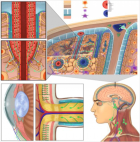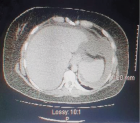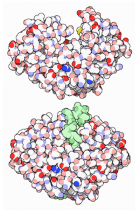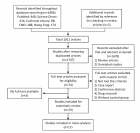Abstract
Opinion
Post-catheterization Common Femoral Artery Pseudoaneurysm in a Patient with a Mechanical Mitral Valve Requiring Anticoagulation: A Case Report
Afolasayo Aromiwura*, Pooja Gandhi, Muhammad Khan and and Jishanth Mattumpuram*
Published: 15 July, 2024 | Volume 8 - Issue 2 | Pages: 072-073
Iatrogenic femoral pseudoaneurysms are a rare complication of transfemoral vascular access. We present a case of a 65-year-old woman with a mechanical mitral valve requiring warfarin, who developed a femoral pseudoaneurysm four days after cardiac catheterization with femoral access. The patient developed a 17 x 10 x 17 cm rectus sheath hematoma and was treated with ultrasound-guided thrombin injection. Anticoagulation was held for three days while the patient was monitored for further bleeding and later restarted based on shared decision-making, given the risk of valve thrombosis. There are few guidelines regarding the re-initiation of anticoagulation in high-risk bleeding patients with mechanical mitral valves. Non-invasive coronary computed tomography angiography should be considered in patients on anticoagulation who require non-emergent cardiac ischemic evaluation.
Read Full Article HTML DOI: 10.29328/journal.jro.1001068 Cite this Article Read Full Article PDF
Keywords:
Common femoral artery; Pseudoaneurysm; Rectus sheath hematoma; Mechanical mitral valve
References
- Gabriel M, Pawlaczyk K, Waliszewski K, Krasiński Z, Majewski W. Location of femoral artery puncture site and the risk of post catheterization pseudoaneurysm formation. Int J Cardiol. 2007;120(2):167-71. Available from: https://www.sciencedirect.com/science/article/abs/pii/S0167527306013155
- Spies JB, Bakal CW, Burke DR, Burke DR, Cardella JF, Dawson SL, et al. Standard for Diagnostic Arteriography in Adults. J Vasc Interv Radiol. 1993;4(3):385-95. Available from: https://www.sciencedirect.com/science/article/abs/pii/S1051044393718850
- Morgan R, Belli AM. Current Treatment Methods for Postcatheterization Pseudoaneurysms. J Vasc Interv Radiol. 2003;14(6):697-710. Available from: https://pubmed.ncbi.nlm.nih.gov/12817037/
- Chun EJ. Ultrasonographic evaluation of complications related to transfemoral arterial procedures. Ultrasonography. 2018;37(2):164-73. Available from: https://pubmed.ncbi.nlm.nih.gov/29145350/
- Corriere MA, Guzman RJ. True and False Aneurysms of the Femoral Artery. Semin Vasc Surg. 2005;18(4):216-23. Available from: https://pubmed.ncbi.nlm.nih.gov/16360579/
- Otto CM, Nishimura RA, Bonow RO, Carabello BA, Erwin JP 3rd, Gentile F, et al. 2020 ACC/AHA Guideline for the Management of Patients With Valvular Heart Disease: A Report of the American College of Cardiology/American Heart Association Joint Committee on Clinical Practice Guidelines. Circulation. 2021;143(5). Available from: https://www.ahajournals.org/doi/full/10.1161/CIR.0000000000000923
- Douketis JD, Spyropoulos AC, Spencer FA, Mayr M, Jaffer AK, Eckman MH, et al. Perioperative Management of Antithrombotic Therapy. Chest. 2012;141(2 Suppl). Available from: https://pubmed.ncbi.nlm.nih.gov/22315266/
- Tomaselli GF, Mahaffey KW, Cuker A, Dobesh PP, Doherty JU, Eikelboom JW, et al. 2020 ACC Expert Consensus Decision Pathway on Management of Bleeding in Patients on Oral Anticoagulants. J Am Coll Cardiol. 2020;76(5):594-622. Available from: https://pubmed.ncbi.nlm.nih.gov/32680646/
- The DISCHARGE Trial Group. CT or Invasive Coronary Angiography in Stable Chest Pain. N Engl J Med. 2022;386(17):1591-602. Available from: https://www.nejm.org/doi/full/10.1056/NEJMoa2200963
Figures:
Similar Articles
-
Post-catheterization Common Femoral Artery Pseudoaneurysm in a Patient with a Mechanical Mitral Valve Requiring Anticoagulation: A Case ReportAfolasayo Aromiwura*, Pooja Gandhi, Muhammad Khan, and Jishanth Mattumpuram*. Post-catheterization Common Femoral Artery Pseudoaneurysm in a Patient with a Mechanical Mitral Valve Requiring Anticoagulation: A Case Report. . 2024 doi: 10.29328/journal.jro.1001068; 8: 072-073
Recently Viewed
-
A study of coagulation profile in patients with cancer in a tertiary care hospitalGaurav Khichariya,Manjula K*,Subhashish Das,Kalyani R. A study of coagulation profile in patients with cancer in a tertiary care hospital. J Hematol Clin Res. 2021: doi: 10.29328/journal.jhcr.1001015; 5: 001-003
-
Influence of COPD on the Diaphragm and Muscles of the Lower LimbsA Meridj*, R Belaala, Y Djeghri. Influence of COPD on the Diaphragm and Muscles of the Lower Limbs. J Pulmonol Respir Res. 2024: doi: 10.29328/journal.jprr.1001061; 8: 056-059
-
Types and Outcomes of Diagnostic Measures provided for women Presented with Postmenopausal BleedingMalaz Elsammani,Sahar Elhawari,Gawahir Murad,Khairi Nasr,Alla Abdelgader,Hajar Suliman,Baharelden Abuobida,Bashir Abdeen,Awadalla Abdelwahid*. Types and Outcomes of Diagnostic Measures provided for women Presented with Postmenopausal Bleeding. Clin J Obstet Gynecol. 2025: doi: 10.29328/journal.cjog.1001186; 8: 030-036
-
Non-surgical Treatment of Verrucous Hyperplasia on Amputation Stump: A Case Report and Literature ReviewSajeda Alnabelsi*, Reem Hasan, Hussein Abdallah, Suzan Qattini. Non-surgical Treatment of Verrucous Hyperplasia on Amputation Stump: A Case Report and Literature Review. Ann Dermatol Res. 2024: doi: 10.29328/journal.adr.1001034; 8: 015-017
-
Epidemioclinical Profile of Inflammatory Ringworm in Children at the Koulikoro Reference Health Centre (Csref)Abdoulaye Kanoute*, Lamissa Cisse, Ramata Fofana. Epidemioclinical Profile of Inflammatory Ringworm in Children at the Koulikoro Reference Health Centre (Csref). Ann Dermatol Res. 2024: doi: 10.29328/journal.adr.1001033; 8: 012-014
Most Viewed
-
Evaluation of Biostimulants Based on Recovered Protein Hydrolysates from Animal By-products as Plant Growth EnhancersH Pérez-Aguilar*, M Lacruz-Asaro, F Arán-Ais. Evaluation of Biostimulants Based on Recovered Protein Hydrolysates from Animal By-products as Plant Growth Enhancers. J Plant Sci Phytopathol. 2023 doi: 10.29328/journal.jpsp.1001104; 7: 042-047
-
Sinonasal Myxoma Extending into the Orbit in a 4-Year Old: A Case PresentationJulian A Purrinos*, Ramzi Younis. Sinonasal Myxoma Extending into the Orbit in a 4-Year Old: A Case Presentation. Arch Case Rep. 2024 doi: 10.29328/journal.acr.1001099; 8: 075-077
-
Feasibility study of magnetic sensing for detecting single-neuron action potentialsDenis Tonini,Kai Wu,Renata Saha,Jian-Ping Wang*. Feasibility study of magnetic sensing for detecting single-neuron action potentials. Ann Biomed Sci Eng. 2022 doi: 10.29328/journal.abse.1001018; 6: 019-029
-
Pediatric Dysgerminoma: Unveiling a Rare Ovarian TumorFaten Limaiem*, Khalil Saffar, Ahmed Halouani. Pediatric Dysgerminoma: Unveiling a Rare Ovarian Tumor. Arch Case Rep. 2024 doi: 10.29328/journal.acr.1001087; 8: 010-013
-
Physical activity can change the physiological and psychological circumstances during COVID-19 pandemic: A narrative reviewKhashayar Maroufi*. Physical activity can change the physiological and psychological circumstances during COVID-19 pandemic: A narrative review. J Sports Med Ther. 2021 doi: 10.29328/journal.jsmt.1001051; 6: 001-007

HSPI: We're glad you're here. Please click "create a new Query" if you are a new visitor to our website and need further information from us.
If you are already a member of our network and need to keep track of any developments regarding a question you have already submitted, click "take me to my Query."

















































































































































